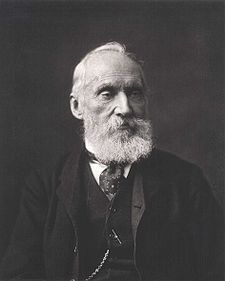
William Thomson, 1st Baron Kelvin, OM, GCVO, PC, PRS, FRSE (26 June 1824 – 17 December 1907) was a British mathematician, mathematical physicist and engineer born in Belfast. Professor of Natural Philosophy at the University of Glasgow for 53 years, he did important work in the mathematical analysis of electricity and formulation of the first and second laws of thermodynamics, and did much to unify the emerging discipline of physics in its contemporary form. He received the Royal Society's Copley Medal in 1883, was its president 1890–1895, and in 1892 was the first British scientist to be elevated to the House of Lords.
Absolute temperatures are stated in units of kelvin in his honour. While the existence of a coldest possible temperature (absolute zero) was known prior to his work, Kelvin is known for determining its correct value as approximately ?273.15 degrees Celsius or ?459.67 degrees Fahrenheit. The Joule–Thomson effect is also named in his honour. Wikipedia
Lord Kelvin, born William Thomson, was a renowned physicist known for his work in thermodynamics and electrical theory. As the mind behind the Kelvin scale of temperature, he was one of the most respected scientists of his time. When he visited Nikola Tesla's lab in 1897, he was initially skeptical of Tesla’s idea for wireless energy transmission, dismissing it as an "illusion and a snare." But after a more detailed explanation from Tesla, Kelvin’s perspective dramatically shifted. Here’s how Tesla described that moment:
“In the summer of 1897 Lord Kelvin happened to pass through New York and honored me by a visit to my laboratory where I entertained him with demonstrations in support of my wireless theory. He was fairly carried away with what he saw but, nevertheless, condemned my project in emphatic terms, qualifying it as something impossible, “an illusion and a snare.” I had expected his approval and was pained and surprised. But the next day he returned and gave me a better opportunity for explanation of the advances I had made and of the true principles underlying the system I had evolved. Suddenly he remarked with evident astonishment: “Then you are not making use of Hertz waves?” “Certainly not,” I replied, “these are radiations. No energy could be economically transmitted to a distance by any such agency. In my system the process is one of true conduction which, theoretically, can be effected at the greatest distance without appreciable loss.” I can never forget the magic change that came over the illustrious philosopher the moment he freed himself from that erroneous impression. The skeptic who would not believe was suddenly transformed into the warmest of supporters. He parted from me not only thoroughly convinced of the scientific soundness of the idea but strongly expressed his confidence in its success…” [Nikola Tesla, “Famous Scientific Illusions.” Electrical Experimenter, February, 1919.]
See Also
